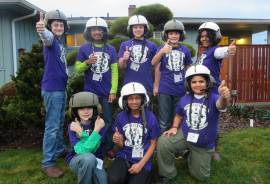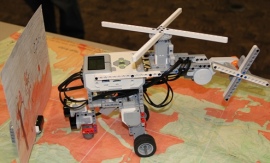
When it comes to finding ways to better protect ourselves from natural disasters, sometimes the best ideas come from unexpected places. Say, for example, a handful of middle school students who are using their award-winning First Lego League model helicopter to make wildland firefighting safer.
The First Lego League Program is designed to get children excited about science and technology and teach them valuable employment and life skills through competition. This year’s competition theme is Nature’s Fury, and students from Jefferson Middle School in Olympia chose to study wildfire for their project—the most common threat in our state.

Photo by Janet Pearce
Their project gained momentum after winning the highest award at the regional competition in Spanaway. The students then went on to win the Western Washington semifinals and have advanced to the state finals in Ellensburg on February 22. If they win that, they hope to conquer the world championship this April in Missouri.
Students’ innovations
The Electrons, the name the students chose for their group, met with DNR firefighter, Weikko Jaross, who told them about the different challenges helicopter pilots and ground crews face while fighting fires. The students came up with four great innovations and presented their ideas to DNR’s Aviation Program staff in December 2013. The Electrons created two innovations to lessen the challenges for firefighting crews.
- First innovation – Automated Water Bucket Drops
This allows the helicopter pilot to automatically count the number of water buckets used and the weight of each bucket. It’s important to know how much water is used on a wildfire for various inventory reasons. For example, firefighters may need to use a reservoir to get water, and DNR will need to track any environmental impacts to that area. - Second innovation – Integrated Infrared Technology
An infrared sensor installed on the bottom of the helicopter provided a heat map in the cockpit, allowing the pilot to identify the best locations to dump water or the hottest point of the fire. The sensor also provides the same information to the grounds crew manager on a handheld device, so he or she can see what the pilot sees.
The two innovations were created to help the pilot focus more on fighting fires and allow the grounds crew manager to position crews more safely.
The Electrons had the opportunity to present their innovations to DNR staff. Their ideas were well received by the aviation crew.
These bright, capable students are keenly interested in the technical, as well as human, factors of fighting wildfires. Who knows? These students could possibly be our next generation of pilots firefighting.
| Follow DNR on: |  |
 |
 |
 |
 |
 |